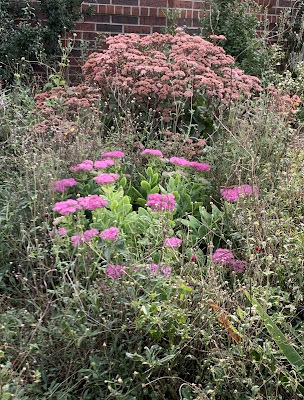 |
'Heritage'
|
Gracious, 4 weeks, almost 5 since ProfessorRoush blogged? Yes, I've been busy, but it is not labor that has kept me from the blog. I've simply lacked the muse, lacked the mood to just sit down and pour out my thoughts. I haven't, however, been absent from the garden, a drained hose there, a peony support removed there, rain gauges put away (for the most part) and the last mowing done.
Tomorrow, it's supposed to snow and freeze down into the teens, so the last delicate 'Heritage' rose above is blooming in vain, no pollinators around to attract, just Mrs. ProfessorRoush to please. I'll bring it and others indoors today, a few last desperate moments in a vase to grace us before, as former Vice-President Biden called it this week, a "dark winter."
I'm thankful now, I am, for all the plants I have planted for fall accents over the years, and for the prairie itself. My back yard is as alive with color in the fall as in the spring, although the tableau goes from pinks and yellows in spring to umbers and tans in fall. Now, with any wet weather, the tall grass prairie lights up with red, grasses full of flame into winter. Big bluestem and little bluestem lift up my landscape and carry the beauty of summer into winter.

In the center of the photograph above, and pictured closeup at left, you can see the yellow beacon of
Amsonia hubrichtii, the 'Arkansas Blue Star'. I planted it decades ago as a trial plant, a low-maintenance plant for the prairie, never realizing how many seasons of joy it will bring. Small bright blue flowers in the summer, feathery trouble-free foliage for backdrop, and then this bright yellow ball into fall, shining as if it has stored the sunshine of summer and reflecting it back in the face of winter. Pest-free, the only trouble it has ever given me is it that it has a tendency to spread by seed, but it is easily recognized and eradicated wherever it pops up.
I've waited several years for this Black Gum tree,
Nyssa sylvatica, to begin to grow and show the potential of its species. From a $10, foot-tall seedling, it has made it in a dozen years into an 8 foot tall, drought-resistant sapling. This year was the first chance I've gotten to see it turn red enough to pick out from across the garden, a mere promise of what I hope it will display in another dozen. I've had to trim the lower branches to be able to mow around it, and I probably slowed the growth of the tree as I did so, but I'm willing to be patient for its full fall foliage impact even if it takes the rest of my lifetime.
That being said, I'm going to cut this blog short today: I just noticed how small and vulnerable this trunk looks and I'm going to run out right now, into the cold damp morning, and get some fencing around it before the young bucks come around and rub the bark off. If there is one thing a Kansas gardener learns, it's preemptive fencing!















